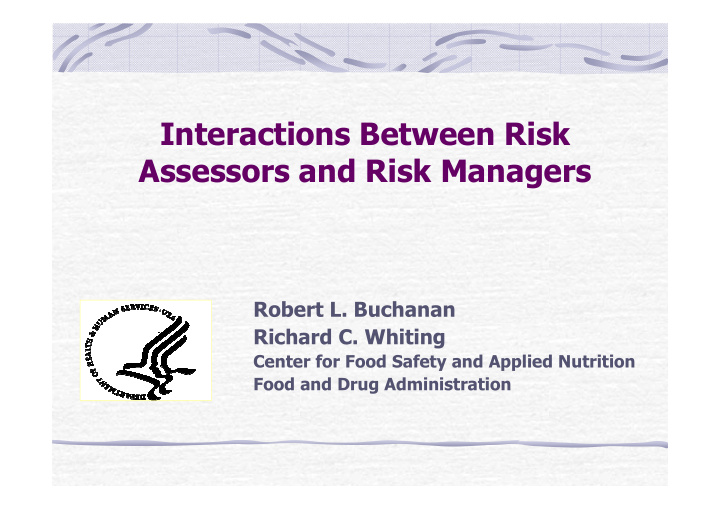



Interactions Between Risk Assessors and Risk Managers Robert L. Buchanan Richard C. Whiting Center for Food Safety and Applied Nutrition Food and Drug Administration
Risk Analysis Traditionally described as being comprised of three components: Risk management Risk Management Risk assessment Risk communication Risk Risk Assessment Communication
Framework for Risk Management Problem/ Context Evaluation Risks Engage Stakeholders Options/ Actions Mitigations Decisions
A Four Phase Selection Process for Risk Assessment Concept Generation Concept Generation Problem Formulation Problem Formulation Feasibility Determination Feasibility Determination Risk Profile Risk Profile Under direction of Risk Managers Decision to proceed Decision to proceed
Risk Analysis Working Groups Policy and risk management team Risk communication team Risk assessment team Project leader Scientists (Microbiologist and food technologist/engineer Modelers & risk assessors Risk manager
Risk Manager Liaison between RA, RM and RC Schedules meetings, sets time lines Handles personnel, budget Oversees clerical, word processing Supervises auditors, proof readers Manages advisory groups, reviewers, public meetings, press releases, public availability of documents Provides time for RA team to work
Risk Management Policy makers: Responsible for setting the objectives of the risk assessment, overall scope, key parameters, questions to be answered by risk assessment Assign people, time, budget
Risk Assessors Must be responsive to the needs of the risk management Describe how assumptions affect the assessment and uncertainty associated with the results Make technical decisions on data analysis, interpretation and modeling Explain limitations of the data on the results of the risk assessment to non-risk assessors
RM and RA Interactions Example from Listeria Risk Assessment RM—One population group should be elderly RA—Best data from CDC groups data at ≥ 60 yr. Is this OK? RM—We’d prefer elderly to be ≥ 65 yr RA—Someone will go to Atlanta for 2 weeks to work through CDC files, $, probably not great difference between 60 and 65 yr old. RM—Use 60 as the criteria for elderly.
RM and RA Interactions Example from Listeria Risk Assessment Cheeses 2001 2003 Fresh Soft Cheese Fresh Soft Cheese Soft mold-ripened & Blue-veined Soft Unripened Cheese cheese > 50% moisture Goat, sheep and feta cheese Soft Ripened Cheese > 50% moisture Aged cheese Semi-soft cheese 39-50% moisture Heat-treated natural & Processed Hard Cheese cheese < 39% moisture Heat-treated natural & Processed cheese
Conclusions Need constant communication: RA should go through each step with RM and describe data and how they will interpret and model the data RM make decisions on objectives and scope RA make decisions on data handling, modeling and output RM and RA must respect the line between them to have an unbiased risk assessment
Recommend
More recommend